World Roundup
May/June 2016


-
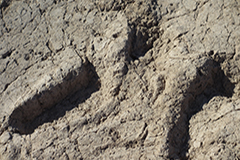 ARIZONA: On a day more than two millennia ago, a group of farmers—at least three adults, with a child and dog—tended fields and irrigation ditches north of Tucson. They left tracks in the mud, and subsequent flooding from a nearby creek covered the footprints in a layer of fine silt. Roadwork has revealed dozens of these preserved prints from that day across 11 separate planting plots. Researchers think they might be the oldest yet found in the Southwest. —Samir S. Patel
ARIZONA: On a day more than two millennia ago, a group of farmers—at least three adults, with a child and dog—tended fields and irrigation ditches north of Tucson. They left tracks in the mud, and subsequent flooding from a nearby creek covered the footprints in a layer of fine silt. Roadwork has revealed dozens of these preserved prints from that day across 11 separate planting plots. Researchers think they might be the oldest yet found in the Southwest. —Samir S. Patel -
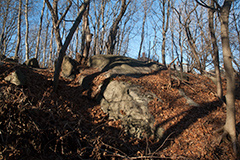 MASSACHUSETTS: Who can forget the Salem witch trials, when 19 were hanged in an episode of mass hysteria in 1692? Documentation of the trials is voluminous, but there are few records of the executions, and the location of the hangings had been forgotten. Experts have now confirmed an earlier theory and pinpointed the site—an outcrop called Proctor’s Ledge—by studying eyewitness accounts, using mapping technology, and analyzing sightlines. Tests show that no remains were buried on the site. —Samir S. Patel
MASSACHUSETTS: Who can forget the Salem witch trials, when 19 were hanged in an episode of mass hysteria in 1692? Documentation of the trials is voluminous, but there are few records of the executions, and the location of the hangings had been forgotten. Experts have now confirmed an earlier theory and pinpointed the site—an outcrop called Proctor’s Ledge—by studying eyewitness accounts, using mapping technology, and analyzing sightlines. Tests show that no remains were buried on the site. —Samir S. Patel -
 PANAMA: Dolphin appears to have been on the menu of the residents of Pedro González Island some 6,000 years ago. In a midden, archaeologists found a relatively high percentage of dolphin bones—common and bottlenose—more than probably would have been available from scavenging beached animals. It is difficult to hunt dolphins from a dugout canoe, so the hunters may have waited until a pod entered a shallow bay, and then used boats to drive their quarry onto the beach. —Samir S. Patel
PANAMA: Dolphin appears to have been on the menu of the residents of Pedro González Island some 6,000 years ago. In a midden, archaeologists found a relatively high percentage of dolphin bones—common and bottlenose—more than probably would have been available from scavenging beached animals. It is difficult to hunt dolphins from a dugout canoe, so the hunters may have waited until a pod entered a shallow bay, and then used boats to drive their quarry onto the beach. —Samir S. Patel -
 SCOTLAND: A skeleton found beneath the playground of Victoria Primary School in Newhaven, Edinburgh, is a reminder that the area once wasn’t so child-friendly. The skeleton was dated to the 16th century, when the site was part of the harbor complex. The bones were quite degraded, and the local graveyards were located elsewhere, so excavators believe that the man may have been a pirate, executed and then displayed—gibbeted, the postmortem punishment is called—to discourage would-be buccaneers. —Samir S. Patel
SCOTLAND: A skeleton found beneath the playground of Victoria Primary School in Newhaven, Edinburgh, is a reminder that the area once wasn’t so child-friendly. The skeleton was dated to the 16th century, when the site was part of the harbor complex. The bones were quite degraded, and the local graveyards were located elsewhere, so excavators believe that the man may have been a pirate, executed and then displayed—gibbeted, the postmortem punishment is called—to discourage would-be buccaneers. —Samir S. Patel -
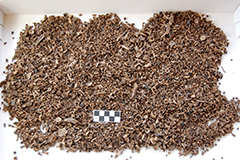 SWEDEN: Osteologists studying a 9,000-year-old lakeside site believe they have found the earliest known example of an important method of food preservation. Below an area thick with fish bones they found a 10-foot-long pit surrounded by postholes. Evidence led them to conclude that these early Mesolithic people were fermenting fish 1,500 years before fermentation was used anywhere else in the world—to make wine. This suggests people may have formed settlements here 3,000 years earlier than previously thought. Surströmming, anyone? —Samir S. Patel
SWEDEN: Osteologists studying a 9,000-year-old lakeside site believe they have found the earliest known example of an important method of food preservation. Below an area thick with fish bones they found a 10-foot-long pit surrounded by postholes. Evidence led them to conclude that these early Mesolithic people were fermenting fish 1,500 years before fermentation was used anywhere else in the world—to make wine. This suggests people may have formed settlements here 3,000 years earlier than previously thought. Surströmming, anyone? —Samir S. Patel -
 SOUTH AFRICA: Australopithecus sediba, the two-million-year-old hominin, differed from other australopiths in its poor ability to bite down on hard foods. Biomechanical tests using a digital model of an A. sediba skull, found in 2008, determined that if A. sediba bit down with all the force of its chewing muscles, it would dislocate its jaw—just like humans, but unlike other australopiths. While this is not proof that A. sediba evolved into modern humans, it does suggest that diet may have played a strong role in human evolution. —Samir S. Patel
SOUTH AFRICA: Australopithecus sediba, the two-million-year-old hominin, differed from other australopiths in its poor ability to bite down on hard foods. Biomechanical tests using a digital model of an A. sediba skull, found in 2008, determined that if A. sediba bit down with all the force of its chewing muscles, it would dislocate its jaw—just like humans, but unlike other australopiths. While this is not proof that A. sediba evolved into modern humans, it does suggest that diet may have played a strong role in human evolution. —Samir S. Patel -
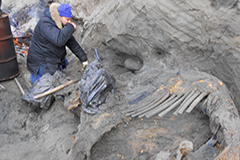 RUSSIA: Modern humans developed the skills to survive just about anywhere on Earth far earlier than was once thought. That is the conclusion after radiocarbon dating the well-preserved remains of a mammoth found by an 11-year-old boy in 2012. The skeleton is studded with signs of a prolonged battle with a group of humans, and dates to about 45,000 years ago, placing humans in the Arctic more than 10,000 years earlier than previous evidence suggested. In fact, the researchers believe that innovations in mammoth hunting made this northern occupation possible. —Samir S. Patel
RUSSIA: Modern humans developed the skills to survive just about anywhere on Earth far earlier than was once thought. That is the conclusion after radiocarbon dating the well-preserved remains of a mammoth found by an 11-year-old boy in 2012. The skeleton is studded with signs of a prolonged battle with a group of humans, and dates to about 45,000 years ago, placing humans in the Arctic more than 10,000 years earlier than previous evidence suggested. In fact, the researchers believe that innovations in mammoth hunting made this northern occupation possible. —Samir S. Patel -
 CAMBODIA: Sometimes the archaeology and ancient history of Cambodia seem to begin and end with Angkor Wat, and it was widely assumed that the period between the decline of Angkor and the modern era was a kind of “dark age.” Excavations at Longvek, the capital after Angkor, are dispelling this notion with evidence of extensive trade links, including maritime trade with China and Japan. The Khmer Empire that built Angkor had not taken advantage of this potential source of wealth, which may have contributed to its decline. —Samir S. Patel
CAMBODIA: Sometimes the archaeology and ancient history of Cambodia seem to begin and end with Angkor Wat, and it was widely assumed that the period between the decline of Angkor and the modern era was a kind of “dark age.” Excavations at Longvek, the capital after Angkor, are dispelling this notion with evidence of extensive trade links, including maritime trade with China and Japan. The Khmer Empire that built Angkor had not taken advantage of this potential source of wealth, which may have contributed to its decline. —Samir S. Patel -
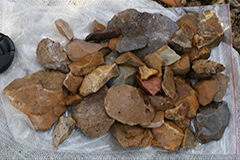 INDONESIA: Archaic humans arrived on Sulawesi at least 118,000 years ago, according to a recently discovered deposit of stone tools and extinct animal bones. It is known that various hominin species made it to the islands of Flores, Java, and Papua by this time, and it was assumed that Sulawesi was part of their dispersal. This new find, accumulated over what appears to have been tens of thousands of years, suggests there was, in fact, a well-established population. There are no human fossils, so it is unknown what ancient human species it was. —Samir S. Patel
INDONESIA: Archaic humans arrived on Sulawesi at least 118,000 years ago, according to a recently discovered deposit of stone tools and extinct animal bones. It is known that various hominin species made it to the islands of Flores, Java, and Papua by this time, and it was assumed that Sulawesi was part of their dispersal. This new find, accumulated over what appears to have been tens of thousands of years, suggests there was, in fact, a well-established population. There are no human fossils, so it is unknown what ancient human species it was. —Samir S. Patel -
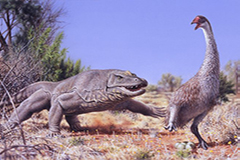 AUSTRALIA: Genyornis newtoni was a seriously large bird: 7 feet tall and 500 pounds. But size doesn’t matter when humans develop a taste for your eggs. Analysis of G. newtoni eggshell fragments from 200 sites across the country describes telltale burn marks produced by a localized heat source rather than the all-encompassing heat of a wildfire—an indication that the eggs had been harvested and cooked. More than 8 in 10 species weighing over 100 pounds, including G. newtoni, became extinct shortly after humans arrived down under around 50,000 years ago. —Samir S. Patel
AUSTRALIA: Genyornis newtoni was a seriously large bird: 7 feet tall and 500 pounds. But size doesn’t matter when humans develop a taste for your eggs. Analysis of G. newtoni eggshell fragments from 200 sites across the country describes telltale burn marks produced by a localized heat source rather than the all-encompassing heat of a wildfire—an indication that the eggs had been harvested and cooked. More than 8 in 10 species weighing over 100 pounds, including G. newtoni, became extinct shortly after humans arrived down under around 50,000 years ago. —Samir S. Patel
Advertisement
IN THIS ISSUE
From the Trenches
Dressing for the Ages
Off the Grid
Let a Turtle Be Your Psychopomp
The Price of Tea in China
What Happened After 1492?
Women in a Temple of Death
Islam North of the Pyrenees
Mesolithic Markings
Vikings, Worms, and Emphysema
Medieval River Engineering
The Death of Joe the Quilter
Egypt’s Immigrant Elite
The First Casus Belli
Artifact
The Wild Man of the medieval world
Advertisement

Recent Issues
-
 May/June 2024
May/June 2024
-
 March/April 2024
March/April 2024
-
 January/February 2024
January/February 2024
-
 November/December 2023
November/December 2023
-
 September/October 2023
September/October 2023
-
 July/August 2023
July/August 2023
-
 May/June 2023
May/June 2023
-
 March/April 2023
March/April 2023
-
 January/February 2023
January/February 2023
-
 November/December 2022
November/December 2022
-
 September/October 2022
September/October 2022
-
 July/August 2022
July/August 2022
-
 May/June 2022
May/June 2022
-
 March/April 2022
March/April 2022
-
 January/February 2022
January/February 2022
-
 November/December 2021
November/December 2021
-
 September/October 2021
September/October 2021
-
 July/August 2021
July/August 2021
-
 May/June 2021
May/June 2021
-
 March/April 2021
March/April 2021
-
 January/February 2021
January/February 2021
-
 November/December 2020
November/December 2020
-
 September/October 2020
September/October 2020
-
 July/August 2020
July/August 2020
-
 May/June 2020
May/June 2020
-
 March/April 2020
March/April 2020
-
 January/February 2020
January/February 2020
-
 November/December 2019
November/December 2019
-
 September/October 2019
September/October 2019
-
 July/August 2019
July/August 2019
-
 May/June 2019
May/June 2019
-
 March/April 2019
March/April 2019
-
 January/February 2019
January/February 2019
-
 November/December 2018
November/December 2018
-
 September/October 2018
September/October 2018
-
 July/August 2018
July/August 2018
-
 May/June 2018
May/June 2018
-
 March/April 2018
March/April 2018
-
 January/February 2018
January/February 2018
-
 November/December 2017
November/December 2017
-
 September/October 2017
September/October 2017
-
 July/August 2017
July/August 2017
-
 May/June 2017
May/June 2017
-
 March/April 2017
March/April 2017
-
 January/February 2017
January/February 2017
-
 November/December 2016
November/December 2016
-
 September/October 2016
September/October 2016
-
 July/August 2016
July/August 2016
-
 May/June 2016
May/June 2016
-
 March/April 2016
March/April 2016
-
 January/February 2016
January/February 2016
-
 November/December 2015
November/December 2015
-
 September/October 2015
September/October 2015
-
 July/August 2015
July/August 2015
-
 May/June 2015
May/June 2015
-
 March/April 2015
March/April 2015
-
 January/February 2015
January/February 2015
-
 November/December 2014
November/December 2014
-
 September/October 2014
September/October 2014
-
 July/August 2014
July/August 2014
-
 May/June 2014
May/June 2014
-
 March/April 2014
March/April 2014
-
 January/February 2014
January/February 2014
-
 November/December 2013
November/December 2013
-
 September/October 2013
September/October 2013
-
 July/August 2013
July/August 2013
-
 May/June 2013
May/June 2013
-
 March/April 2013
March/April 2013
-
 January/February 2013
January/February 2013
-
 November/December 2012
November/December 2012
-
 Sep/Oct 2012
Sep/Oct 2012
-
 September/October 2012
September/October 2012
-
 July/August 2012
July/August 2012
-
 May/June 2012
May/June 2012
-
 March/April 2012
March/April 2012
-
 January/February 2012
January/February 2012
-
 November/December 2011
November/December 2011
-
 September/October 2011
September/October 2011
-
 July/August 2011
July/August 2011
-
 May/June 2011
May/June 2011
-
 March/April 2011
March/April 2011
-
 January/February 2011
January/February 2011
Advertisement






